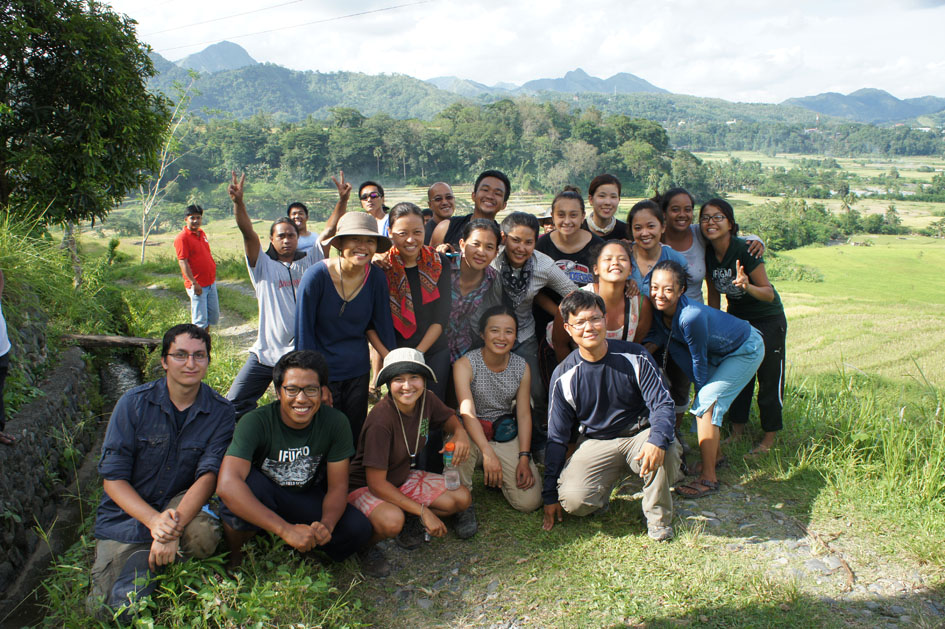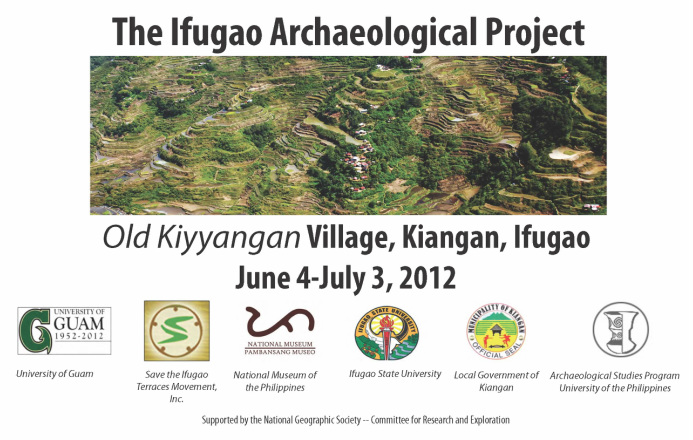|
Today marks the end of the excavations at the Old Kiyyangan Village, Kiangan, Ifugao. Typical of most archaeological excavations, important findings and interesting artifacts start showing up towards the end of the field season. So far, the crew's discoveries support the idea that the Old Kiyyangan Village predated the arrival of the Spanish in Northern Luzon. Trench 3, a unit located in what is believed to be an area where a bale (house) once stood (based on Ifugao settlement pattern) provided three occupational layers and three distinct pottery frequency -- cooking jars in the upper layers, cooking jars, water jars, and tradeware ceramics in the second occupational layers, and water jars in the lower levels. The prevalence of cooking jar sherds in the upper levels suggest that the area was used as a rice field, where cooking jars where brought as containers of cooked rice, while the prevalence of water jars in the lower levels indicate that the area was once a location of a house -- water jars are not transported owing to their size and weight.  Ceramics on the lower levels also provided a hint that the lower occupational layers predated the arrival of the Spanish in northern Luzon -- complete absence of tradeware ceramics (stoneware and porcelain). Although tradeware ceramics were being traded in the lowlands as early as the 10th Century C.E., it is difficult to pinpoint the exact period when the Old Kiyyangan Village was first established based on the ceramics alone. We are hoping that C14 dates and soil analysis would provide this information. In addition, soil analyses will also provide evidence for initial rice cultivation as well as the pre-rice landscape and vegetation cover of the area.  Other findings include the discovery of three whole pots in Trench 4 (another bale location), the conclusion that the buried walls in Trench 1 were once an irrigation ditch, which suggests that the almost .5 km strip of land between the current rice fields and the junction of Ibulao and Ambangal Rivers might have held more rice fields, a whole water jar in Trench 5 (located near Trench 1), and that the primary source of protein among Old Kiyyangan settlers is deer meat (70% of faunal remains recovered are deer bones). The IAP crew is also scheduled to provide Ifugao community a brief report on the discoveries of the excavations on June 29, 2012 at the National Museum-Kiangan Branch. Included in this activity are student presentations based on preliminary analysis of artifacts and ecofacts discovered in the village as well as an exhibit at the National Museum-Kiangan Branch. The exhibit highlights pottery types from Old Kiyyangan that were previously undocumented and the place of the village in the history of Ifugao.  Today, we were also visited by a group of high school students from Saint Joseph School. We are hoping that public engagement will change local communities' perception of archaeology as a treasure hunting enterprise. In addition, the exposure of the students might provide the impetus for an interest in anthropology/archaeology.
2 Comments
The first field season of the Ifugao Archaeological Project will be launched June 6, 2012 at the Old Kiyyangan Village, Kiangan, Ifugao. The IAP will also run the 2012 UOG Ifugao Archaeological Field School, in collaboration with the Save the Ifugao Terraces Movement, Inc., National Museum of the Philippines, Ifugao State University, University of the Philippines, and the Kiangan Local Government Unit.
This year's investigations will focus on the Old Kiyyangan Village, the putative first Ifugao village according to Ifugao mythology. The area is located, about four (4) kilometers from Kiangan Poblacion. There are different versions of this origin myth, Barton (1955) records one story that appeared in his The Mythology of the Ifugaos. The myth recorded by Barton was provided by Pumihic Pablo, a mumbaki (Ifugao religious practitioner) of the Puitan District and was confirmed by two other mumbaki from Bo-oh (present-day Bocos) village in Banaue, Tabayag and Pahitte. As the site is believed to be one of the oldest in the area, our excavations hope to provide radiocarbon dates that will contribute to the culture history and chronology of the region. Rober Maher did some excavations in the site during the early 1980s, but his dates were inconclusive. With advances in technology and the practice of chronometric hygiene, we are hoping to establish baseline information to the development of Cordillera terrace-building tradition. Overall, the Ifugao Archaeological Project hopes to contribute to Ifugao scholarship and to the development of sustainable conservation plans for the rice terraces. The Ifugao Rice Terraces illustrate humanity’s relationship with the environment. The complexity of Ifugao agricultural and irrigation systems, however, is still poorly understood. Building on my previous and ongoing work among the Ifugao, this project examines anthropological issues that include relationship between agricultural and irrigation systems with emergent complexity; pathways to intensification; and organizational entailments of irrigation systems. Such work informs on theoretical foundations of studies of agricultural systems and social organization by applying the model of self organizing systems, providing empirical data to similar studies in island Southeast Asia and elsewhere (the Andes, Spain), and provides an historical ecological approach in the study of emergent complexity. This study will add a new perspective in the recursive relationship between humans and their landscape. This year's field school features participants from the University of Guam (Charmaine Ledesma, Jacy Moore, Mariana Sanders, Joffrey Martinez, Vanessa Cabrera); University of Toronto (Jay Allen Villapando); SUNY-Oneonta (Maddie Yakal); UCLA (Ellen Hsieh); University of British Columbia (Narae Lee); UC-Riverside (Mikhail Echavarri); University of the Philippines-Archaeological Studies Program (Marie Sioco, Mindy Ceron, Kate Tantuico); and, University of Hawaii-Luce Asian Archaeology Program (Lun Votey, Mita Muong, both from Cambodia). The field school is directed by Stephen Acabado (University of Guam) and co-directed by Marlon Martin (CEO, SITMo), Ana Labrador (Assistant Director, National Museum), Grace Barretto-Tesoro (University of the Philippines), and John Peterson (University Guam). The IAP is partially supported by a National Geographic Society-Committee for Research and Exploration Grant. We hope to see you there! |
Stephen AcabadoI am an anthropological archaeologist interested in human-environment interactions Archives
June 2012
Categories
All
|





 RSS Feed
RSS Feed
